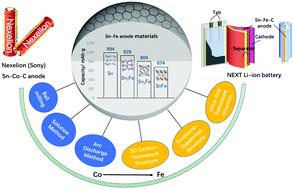当前位置:
X-MOL 学术
›
Mater. Chem. Front.
›
论文详情
Our official English website, www.x-mol.net, welcomes your feedback! (Note: you will need to create a separate account there.)
Recent development of Sn–Fe-based materials as a substitute for Sn–Co–C anodes in Li-ion batteries: a review
Materials Chemistry Frontiers ( IF 7 ) Pub Date : 2020-10-30 , DOI: 10.1039/d0qm00582g Zuopeng Lin 1, 2, 3, 4, 5 , Xuexia Lan 1, 2, 3, 4, 5 , Xingyu Xiong 1, 2, 3, 4, 5 , Renzong Hu 1, 2, 3, 4, 5
Materials Chemistry Frontiers ( IF 7 ) Pub Date : 2020-10-30 , DOI: 10.1039/d0qm00582g Zuopeng Lin 1, 2, 3, 4, 5 , Xuexia Lan 1, 2, 3, 4, 5 , Xingyu Xiong 1, 2, 3, 4, 5 , Renzong Hu 1, 2, 3, 4, 5
Affiliation

|
Tin based alloy materials have been widely studied as alternative anodes to replace the graphite anode in high energy density lithium-ion batteries (LIBs) due to their higher specific capacity and moderate lithiation potentials. Since 2005, Sony Company has applied a ternary Sn–Co–C alloy anode in an LIB with the trademark “Nexelion”, which has 30% increase in capacity and 20% increase in volumetric energy density in comparison to the conventional cells using graphite anodes. However, the high cost of Co, difficulties in preparing amorphous materials and unsatisfactory lifetime of this anode material have inhibited the wide commercialization of the “Nexelion” battery. Thus, in the past decade, intensive investigations have been focused on Sn–Fe and especially Sn–Fe–C alloy anodes using abundant and inexpensive Fe element. In this review, the advances of the Sn–Co and then Sn–Fe alloy based composite as anode materials for LIBs have been reviewed in detail, including the structural optimizations, preparation methods and enhancements in electrochemical performance. It is aimed to demonstrate that the cycling performance of Sn–Fe–C anode materials can be significantly enhanced by rational design of both the compositions and crystal structures of Sn–Fe intermetallic phases, and the dispersive state, morphology and surface features in the carbonaceous matrix. These concepts and strategies could also be beneficial for solving the cycling stability issue of other alloy-type anode materials in advanced metal-ion batteries for practical applications.
中文翻译:

Sn-Fe基材料替代锂离子电池中Sn-Co-C阳极的最新进展:综述
锡基合金材料由于其较高的比容量和适度的锂化潜力,已被广泛研究用作替代阳极,以替代高能量密度锂离子电池(LIB)中的石墨阳极。自2005年以来,索尼公司已在LIB中使用商标为“ Nexelion”的三元Sn-Co-C合金阳极,与使用石墨阳极的传统电池相比,其容量增加了30%,体积能量密度增加了20% 。然而,Co的高成本,制备无定形材料的困难以及该负极材料的寿命不令人满意,已经抑制了“ Nexelion”电池的广泛商业化。因此,在过去的十年中,对使用大量廉价的铁元素的Sn-Fe尤其是Sn-Fe-C合金阳极进行了深入的研究。在这篇评论中 综述了以锡钴合金,然后以锡铁合金为基础的复合材料作为锂离子电池负极材料的研究进展,包括结构优化,制备方法和电化学性能的提高。旨在证明通过合理设计Sn-Fe金属间相的组成和晶体结构以及碳质碳纳米管中的分散状态,形态和表面特征,可以显着提高Sn-Fe-C阳极材料的循环性能。矩阵。这些概念和策略也可能有益于解决实际应用中高级金属离子电池中其他合金型阳极材料的循环稳定性问题。包括结构优化,制备方法和电化学性能的增强。旨在证明通过合理设计Sn-Fe金属间相的组成和晶体结构以及碳质碳纳米管中的分散状态,形态和表面特征,可以显着提高Sn-Fe-C阳极材料的循环性能。矩阵。这些概念和策略也可能有益于解决实际应用中高级金属离子电池中其他合金型阳极材料的循环稳定性问题。包括结构优化,制备方法和电化学性能的增强。旨在证明通过合理设计Sn-Fe金属间相的组成和晶体结构以及碳质碳纳米管中的分散状态,形态和表面特征,可以显着提高Sn-Fe-C阳极材料的循环性能。矩阵。这些概念和策略也可能有益于解决实际应用中高级金属离子电池中其他合金型负极材料的循环稳定性问题。旨在证明通过合理设计Sn-Fe金属间相的组成和晶体结构以及碳质碳纳米管中的分散状态,形态和表面特征,可以显着提高Sn-Fe-C阳极材料的循环性能。矩阵。这些概念和策略也可能有益于解决实际应用中高级金属离子电池中其他合金型阳极材料的循环稳定性问题。旨在证明通过合理设计Sn-Fe金属间相的组成和晶体结构以及碳质碳纳米管中的分散状态,形态和表面特征,可以显着提高Sn-Fe-C阳极材料的循环性能。矩阵。这些概念和策略也可能有益于解决实际应用中高级金属离子电池中其他合金型阳极材料的循环稳定性问题。
更新日期:2020-12-10
中文翻译:

Sn-Fe基材料替代锂离子电池中Sn-Co-C阳极的最新进展:综述
锡基合金材料由于其较高的比容量和适度的锂化潜力,已被广泛研究用作替代阳极,以替代高能量密度锂离子电池(LIB)中的石墨阳极。自2005年以来,索尼公司已在LIB中使用商标为“ Nexelion”的三元Sn-Co-C合金阳极,与使用石墨阳极的传统电池相比,其容量增加了30%,体积能量密度增加了20% 。然而,Co的高成本,制备无定形材料的困难以及该负极材料的寿命不令人满意,已经抑制了“ Nexelion”电池的广泛商业化。因此,在过去的十年中,对使用大量廉价的铁元素的Sn-Fe尤其是Sn-Fe-C合金阳极进行了深入的研究。在这篇评论中 综述了以锡钴合金,然后以锡铁合金为基础的复合材料作为锂离子电池负极材料的研究进展,包括结构优化,制备方法和电化学性能的提高。旨在证明通过合理设计Sn-Fe金属间相的组成和晶体结构以及碳质碳纳米管中的分散状态,形态和表面特征,可以显着提高Sn-Fe-C阳极材料的循环性能。矩阵。这些概念和策略也可能有益于解决实际应用中高级金属离子电池中其他合金型阳极材料的循环稳定性问题。包括结构优化,制备方法和电化学性能的增强。旨在证明通过合理设计Sn-Fe金属间相的组成和晶体结构以及碳质碳纳米管中的分散状态,形态和表面特征,可以显着提高Sn-Fe-C阳极材料的循环性能。矩阵。这些概念和策略也可能有益于解决实际应用中高级金属离子电池中其他合金型阳极材料的循环稳定性问题。包括结构优化,制备方法和电化学性能的增强。旨在证明通过合理设计Sn-Fe金属间相的组成和晶体结构以及碳质碳纳米管中的分散状态,形态和表面特征,可以显着提高Sn-Fe-C阳极材料的循环性能。矩阵。这些概念和策略也可能有益于解决实际应用中高级金属离子电池中其他合金型负极材料的循环稳定性问题。旨在证明通过合理设计Sn-Fe金属间相的组成和晶体结构以及碳质碳纳米管中的分散状态,形态和表面特征,可以显着提高Sn-Fe-C阳极材料的循环性能。矩阵。这些概念和策略也可能有益于解决实际应用中高级金属离子电池中其他合金型阳极材料的循环稳定性问题。旨在证明通过合理设计Sn-Fe金属间相的组成和晶体结构以及碳质碳纳米管中的分散状态,形态和表面特征,可以显着提高Sn-Fe-C阳极材料的循环性能。矩阵。这些概念和策略也可能有益于解决实际应用中高级金属离子电池中其他合金型阳极材料的循环稳定性问题。


























 京公网安备 11010802027423号
京公网安备 11010802027423号